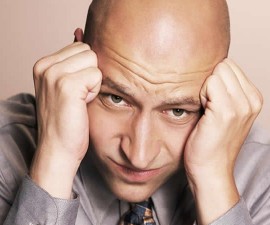A common hair loss problem that takes attention for men is receding hairline. While for some it is considered not more than the sign of changing their hairstyles, others concern it seriously. Some treatments are available, but what will happen if your receding hairline is not treated? The prognosis can vary.
Does receding hairline always lead to baldness?
If you experience receding front hairline, baldness may be one of the most feared things you concern. It’s undeniable that it is often associated with baldness. Even it has been officially recognized as an early sign of male pattern baldness (MPB).
MPB is a hereditary condition, though it is not always linked to genetic trait. If you have a family history of MPB, you are likely to have a faulty gene that puts you at high risk of developing the same thing. This genetic trait factor is unchangeable. However some treatments are available for coping.
Pattern baldness in women is called female pattern baldness (FPB). Unlike in men, women with FPB usually don’t experience receding front hairline. Typically, thinning hair affects the entire scalp.
While some may eventually experience baldness, others will have partial baldness. However, this is also dependent on the treatment you take. With appropriate treatment you can stop it and make it grow back. See more about this topic in this section!
How long does it take?
The progression of the problem can take years, and it also can vary from man to man. While it can occur earlier (even before the age of 20, in rare case), it also sometimes strikes after the age of 40!
But typically, it is usually noticed for the first time at the ages of late 20s and early 30s. See more how long it will progress in this previous post!
If it does associated with MPB, you will also experience thinning hair on the crown. Eventually, the spots of thinning hair on the temples and crown meeting each other, causing a horseshoe shape.
Is it reversible?
If compared to other hair loss problems (especially those that are associated with lifestyle factors) MPB is more difficult to reverse. However as noted before, some treatment options are available.
Propecia is a common choice to help treat receding hairline associated with MPB. It can help address the underlying cause of the problem.
Men with MPB are more sensitive to DHT (dihydrotestosterone). Excess DHT can destroy their hair follicles and prevent them from growing back. Propecia can help control DHT.
If you have adequate budget and do concern about your receding front hairline, you can consider taking hair transplant. The good news, most men with MPB are able to take hair transplant – but it is costly.
Depending on the kind of treatment you take, the problem will go away temporary or permanently.
Temporary means hair loss is likely to come back if you stop taking the treatment. See more about the chance to reverse receding hairline in here!
Can receding hairline become cancer?
It is rarely associated with certain serious medical condition, including cancer. Mostly, it is harmless or doesn’t put you at high risk of developing other conditions.
The treatment is commonly used for cosmetic reasons. It’s very rare when people need to treat it because it will cause serious complications!
In general, the worst thing is not more than the risk of becoming baldness. Even many men decide to leave it untreated!
Furthermore, there are plenty of hairstyles for receding hairline that can help boost your confidence. So the decision of treating it is optional.
What are the treatment options?
Hair transplant is not always the end of your option to cope with this hair loss problem. There are plenty of options to help treat it. Here is a comprehensive guide you need to read to help cope with your receding hairline!




